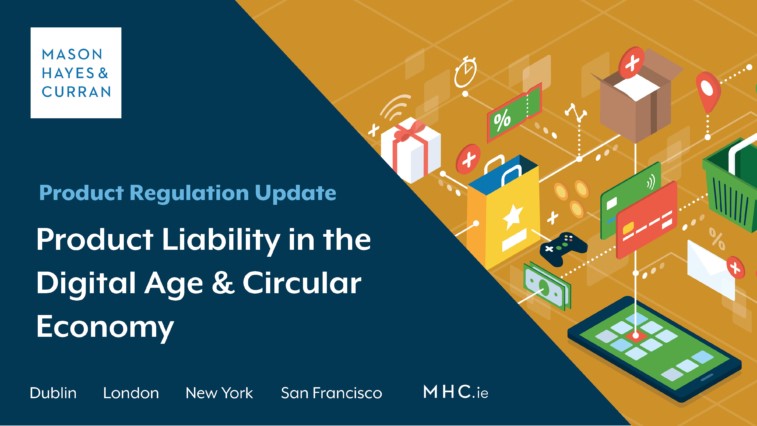
The European Commission (Commission) launched a public consultation on the adoption of product liability rules to the digital age and circular economy on 18 October 2021. This was based on the Commission’s Inception Impact Assessment dated 30 June 2021 on the same subject and is part of the Commission’s wider efforts to revise EU law to reflect the evolution of technology.
The rise of the digital economy is paving the way for a proliferation of artificial intelligence (AI). The Commission recognises that AI is “benefiting our society and economy but also presents potential risks”. Similarly, the transition to a circular economy, which enables extending the life of materials and upgrading and repairing products and components, benefits the environment. However, it also raises concerns around liability for any subsequent damage. In this regard, the Commission highlights the importance of having a regulatory framework that:
- Provides legal certainty to companies about the risks they take in the course of their business
- Encourages the prevention of damage, and
- Ensures injured parties are compensated.
Gaps in the current liability rules
The existing liability framework consists of the Product Liability Directive (85/374/EEC) (Directive) and national liability rules. In the EU, the Directive harmonises one group of claims, namely those against a producer for harm to a consumer due to the defectiveness of a product.
The Commission states that there are challenges to applying the current liability rules to certain features of digital technologies. These challenges include:
- The intangibility of digital products
- Their dependence on data
- Their complexity, and connectivity, and
- Features specific to AI, such as autonomous behaviour, limited predictability, continuous adaptation, and opacity.
This creates legal uncertainty for businesses and may make it difficult for consumers and other injured parties to receive compensation.
The overall objective of the Commission’s initiative is to ensure the proper functioning of the internal market as well as a high level of consumer/user protection. More specifically, the Commission’s objectives, which it is proposed will be achieved through several policy options, are twofold:
- To adapt and modernise strict liability rules to the digital age and circular economy, and
- To reduce obstacles to receiving compensation for damage under the Directive.
The Commission proposes to achieve these objectives through a number of policy options as discussed below.
Digital age and circular economy: liability rules not fit for purpose
In its Inception Impact Assessment, the Commission addresses several shortcomings in relation to the application of the current liability rules to digital technologies, which it had previously identified in its 2018 report evaluating the Directive (2018 Report), namely:
- The intangibility of digital products: it is unclear as to what extent digital technologies can be classified as ‘products’ under the Directive. Accordingly, it is unclear whether injured parties can be compensated for damage caused by software, including software updates, and who would be liable for such damage.
- Connectivity and cybersecurity: The Directive provides for compensation for physical or material damage only. It is therefore unclear if the concept of ‘defect’ under the Directive extends to the cyber vulnerabilities to which new technologies are exposed, including cybersecurity risks, risk of damage to digital assets and privacy infringements.
- Complexity: The complexity of digital technologies could make it very difficult for an injured party to identify the producer responsible. Moreover, the Commission observes that the digital age has brought about changes to the supply chain. For instance, the rise of online marketplaces, through which consumers can purchase products from outside the EU without an importer. Under the Directive, importers are treated as producers for product liability purposes. In such circumstances, without an importer, consumers are left with no liable person from whom they can seek compensation for damage under the Directive.
Furthermore, the specific characteristics of AI, such as autonomous behaviour, continuous adaptation, limited predictability, and opacity, make it difficult to get compensation for damages under the Directive and national civil liability rules and the extent to which national ‘strict liability’ rules would be applied. It also makes it difficult for economic stakeholders to understand their liability with sufficient certainty.
In relation to the circular economy, the Commission points out that under the Directive, the defectiveness of a product is determined the moment it is put into circulation. Accordingly, it is unclear who should be liable for defects resulting from changes to products after they are put into circulation. This may arise, for example, where a product is repaired, recycled, refurnished, or upgraded as part of the EU’s objective to achieve sustainability and waste-reduction. The Commission further points out that environmental damage cannot yet be compensated under the Directive.
Obstacles to obtaining compensation
The Commission states in its Inception Impact Assessment that the complexity of certain products, such as pharmaceutical products and products using emerging digital technologies, make it difficult for injured parties to prove that a defect caused the damage of which they complain. This is particularly so in relation to certain AI products and services, whose specific characteristics could make it difficult and costly for an injured party to prove the necessary elements of their claim.
The Commission states that this heavy burden of proof could be compounded by an injured party being disadvantaged by insufficient technical information about AI products and services.
Further in relation to AI products and services, the Commission expresses concern about:
- The risk of national courts applying diverging interpretations of liability rules in relation to damage caused by AI, which could create further fragmentation of the liability rules across the EU, and
- The lack of clarity about whether damage caused by unpredictable outcomes from continuous learning and adaptation in AI-equipped products can be treated as a ‘defect’ under the Directive. The Commission states that, even if they can be, the Directive’s ‘development risk defence’ would exempt producers from liability for a defect that was not discoverable when the product was put into circulation.
Lastly, the Commission notes that the Directive’s restrictions in relation to time limits and the minimum threshold for property damage of €500 may excessively limit claims by injured parties.
The Commission’s consultation
The Commission has indicated that the purpose of the consultation, specifically, is to:
- Confirm the relevance of the issues identified in the 2018 Report, and
- Collect information on the need and possible ways to address the specific challenges arising from the uses of AI systems
The response period for this consultation closed on 10 January 2022. The adoption of the initiative is currently planned for the third quarter of 2022. Stakeholders would be advised to keep abreast of legislative developments in this space.
For more information, contact a member of our Product Regulation & Consumer Law team.
The content of this article is provided for information purposes only and does not constitute legal or other advice.





